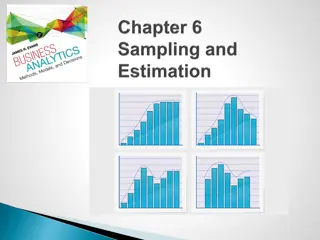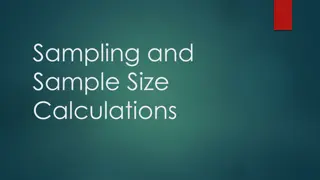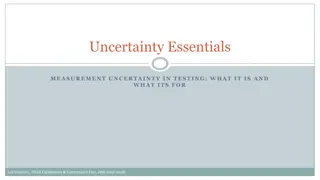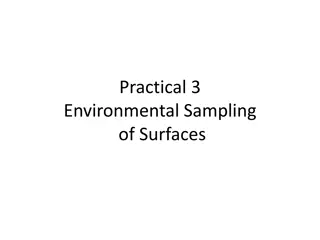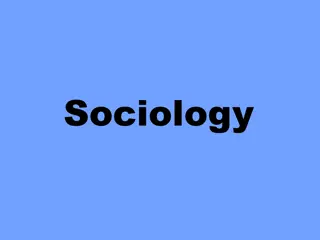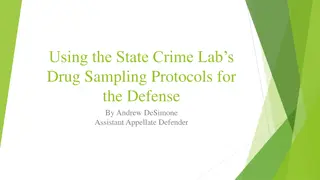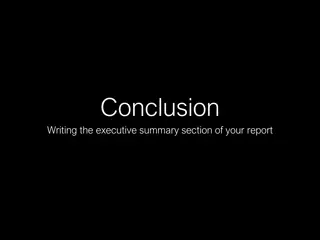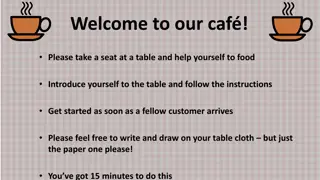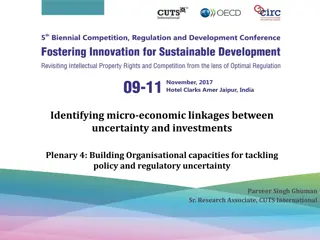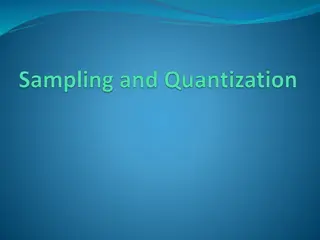Sampling Methods in Statistical Analysis
Sampling is a crucial process in statistical analysis where observations are taken from a larger population. Different sampling techniques are used based on the analysis being performed. Sampling methods help in studying populations when studying the entire population is not feasible. There are two
0 views • 8 slides
Sampling Under the RRF - General Principles and Methods
Sampling under the RRF is essential for the Commission to ensure reasonable assurance of fulfillment of numerical milestones or targets. The approach involves statistical risk-based random sampling with specific thresholds and considerations for different types of milestones. Various statistical tab
0 views • 12 slides
Non-Probability Sampling Methods
Non-probability sampling methods involve selecting samples based on subjective judgment rather than random selection. Types include convenience sampling, quota sampling, judgmental (purposive) sampling, and snowball sampling. Convenience sampling picks easily available samples, quota sampling select
5 views • 7 slides
Systematic Analysis of Real Samples in Analytical Chemistry
This analysis covers the systematic process involved in analyzing real samples, including sampling, sample preservation, and sample preparation. It discusses the importance of accurate sampling in obtaining information about various substances, such as solids, liquids, gases, and biological material
0 views • 54 slides
Sampling Plans in Statistical Analysis
Sampling is vital for statistical analysis, with sampling plans detailing objectives, target populations, operational procedures, and statistical tools. Different sampling methods like judgmental, convenience, and probabilistic sampling are used to select samples. Estimation involves assessing unkno
2 views • 36 slides
Sampling Methods and Errors in Research
Sampling is crucial in research to draw conclusions about a population. Various methods like simple random sampling, stratified sampling, and systematic sampling help in selecting representative samples. Sampling error arises due to differences between sample and population values, while bias leads
2 views • 12 slides
Measurement Uncertainty in Testing: Essentials and Guidelines
Measurement uncertainty in testing is a crucial aspect that characterizes the dispersion of values attributed to a measurand. This uncertainty plays a key role in reporting accurate test results, requiring careful evaluation of all significant contributions. The ISO/IEC Guide 98 GUM provides essenti
2 views • 18 slides
Fundamentals of Food Sampling and Analysis
Discover the key methods and procedures for sampling, transportation, and storage of environmental parameters, focusing on food sampling and analysis. Explore the importance of representative samples, quality analysis results, and risks associated with sampling. Learn about homogeneous vs. heterogen
6 views • 36 slides
Sampling and Signal Processing Fundamentals
Sampling plays a crucial role in converting continuous-time signals into discrete-time signals for processing. This lecture covers periodic sampling, ideal sampling, Fourier transforms, Nyquist-Shannon sampling, and the processing of band-limited signals. It delves into the relationship between peri
2 views • 60 slides
Biases in Sampling Methods
Statistical studies rely on samples to draw conclusions about populations, but the method of sampling can introduce biases. This text discusses convenience sampling, voluntary response sampling, random sampling, and the implications of biased sampling methods on study results. It highlights how bias
1 views • 12 slides
Guide to Environmental Surface Sampling Techniques
Understanding the importance of environmental surface sampling is crucial for ensuring hygiene and safety. This guide covers key aspects such as pre-sampling considerations, aseptic techniques, major sampling methods like RODAC plate, swab, and wipe methods, along with detailed procedures for each m
1 views • 16 slides
Lead Dust Wipe Sampling Techniques and Guidelines
This resource provides valuable information on lead dust wipe sampling techniques for Lead Dust Sampling Technicians. It covers the objectives, measuring lead dust, sampling strategy, sampling locations based on EPA RRP Rule, and HUD clearance regulations. Techniques for taking dust wipe samples, id
2 views • 41 slides
Comprehensive Guidelines for Meth Residue Sampling by Local Health Departments
This detailed guide outlines the procedures and protocols for meth residue sampling conducted by local health departments. It covers the reasons for sampling, the importance of qualified inspectors, testing methodologies, sampling kits assembly, and more. Key points include when and why sampling is
3 views • 19 slides
Sampling in Survey Research
This content covers essential concepts of survey research, statistics, and sampling methods. It delves into elements of the sampling problem, technical terms, and how to select a sample for surveys. The discussions revolve around population parameters, sampling procedures, and the control of informa
2 views • 39 slides
Sampling in Social Research Methods
Sampling in social research involves selecting a portion of a population to draw conclusions about the entire group. It helps save time, money, and allows for accurate measurements. The key principles of sampling include systematic selection, clear definition of sample units, independence of units,
0 views • 19 slides
Non-Probability Sampling Methods
Non-probability sampling involves selecting samples based on subjective judgment rather than random selection, leading to a lack of equal chances for all population members to participate. Various types include convenience sampling, quota sampling, judgmental sampling, and snowball sampling. Conveni
1 views • 7 slides
Sampling in Artificial Intelligence: An Overview
Exploring the concept of sampling in artificial intelligence, particularly in the context of Bayesian networks. Sampling involves obtaining samples from unknown distributions for various purposes like learning, inference, and prediction. Different sampling methods and their application in Bayesian n
2 views • 29 slides
Approximate Inference in Bayes Nets: Random vs. Rejection Sampling
Approximate inference methods in Bayes nets, such as random and rejection sampling, utilize Monte Carlo algorithms for stochastic sampling to estimate complex probabilities. Random sampling involves sampling in topological order, while rejection sampling generates samples from hard-to-sample distrib
0 views • 9 slides
State Crime Lab Drug Sampling Protocols
Using the State Crime Lab's drug sampling protocols for defense involves understanding three sampling methods: administrative sample selection, threshold sample selection, and hypergeometric sampling plan. The hypergeometric plan allows experts to make assumptions about the chemical composition of u
1 views • 30 slides
Sampling Variability in Statistical Analysis
Random sampling is crucial in statistical analysis to minimize sampling error. Sampling variability occurs due to chance when a random sample is surveyed instead of the entire population. Different units selected can lead to slightly varied estimates. It's important to understand and address samplin
3 views • 31 slides
Non-Probability Sampling Methods
Non-probability sampling involves selecting samples based on subjective judgement rather than random selection. This method may not give all population members an equal chance to participate. Types include convenience sampling, quota sampling, judgemental sampling, and snowball sampling.
2 views • 7 slides
Sampling Methods in Research
Explore key concepts in sampling such as probability and non-probability methods, sampling error, representativeness, and types of biases. Learn about the importance of sampling in research, theoretical variables, conceptualization, and operationalization. Evaluate different types of sampling proces
4 views • 20 slides
Non-Probability Sampling Techniques in Nursing Research
Non-probability sampling in nursing research involves selecting samples subjectively rather than randomly. This sampling method carries a higher risk of bias and limits statistical inference about the entire population. Five main types include convenience, purposive, quota, snowball, and voluntary r
3 views • 30 slides
Strategies Used by General Practitioners to Manage Uncertainty in Practice
General Practitioners (GPs) encounter uncertainty in their practice and utilize various strategies to address it. These strategies include safety netting, seeking advice from colleagues, sharing uncertainty with patients, review/follow-up processes, investigations, building rapport, and more. Collea
1 views • 35 slides
Sampling Uncertainty: A Comprehensive Overview
Sampling uncertainty arises due to variations in sample values, impacting statistical estimates. Larger samples reduce uncertainty, providing more precise estimates. Adequate sample sizes are crucial, especially for comparing different groups or magnitudes of effects. By quantifying uncertainty, res
0 views • 27 slides
Sampling: Importance, Process, and Errors Explained
This content delves into the world of sampling, exploring why sampling is crucial, the sampling process involving defining populations and calculating sample sizes, and the distinction between non-sampling and sampling errors. It covers the significance of representative samples, common errors in sa
0 views • 15 slides
Sampling and Surveys: Understanding Population and Sample
In statistics, understanding the population and sample is crucial. Learn about different sampling methods, such as voluntary response and convenience sampling, and how they can introduce bias. Explore techniques like simple random sampling, stratified random sampling, and cluster sampling. Discover
1 views • 54 slides
Uncertainty in Health Measurements
Concept of uncertainty in health measurements is crucial for ensuring accuracy in diagnostic processes. This involves factors such as within-run precision, between-run precision, calibrator coverage, mean calculations, standard deviation, and expanded uncertainty. Proper calibration, repeated testin
0 views • 18 slides
Measuring Uncertainty in the Financial Sector: Insights and Challenges
The paper explores the concept of uncertainty in the financial sector, proposing a novel measure using expectation errors of managers. It discusses the impact of uncertainty on economic activity, drawing from relevant literature and financial services survey data. The study aims to address the lack
0 views • 19 slides
Micro-economic Linkages Between Uncertainty and Investments
This content delves into the interlinkages between uncertainty and investments at a micro-economic level, focusing on the impact of global economic policy uncertainty on investment flows. It highlights the relationship between uncertainty and investments in both advanced and emerging economies, disc
0 views • 7 slides
Overview of Sampling Methods in Markov Chain Monte Carlo
This content covers various sampling methods in Markov Chain Monte Carlo including Rejection Sampling, Importance Sampling, and MCMC Sampling. It delves into representing distributions, drawbacks of Importance Sampling, and the motivation behind Markov Chain Monte Carlo Sampling. The illustrations p
0 views • 25 slides
Sampling Technique For Quantitative Data Presentation
This presentation focuses on sampling techniques for quantitative data collection in research studies. It covers concepts such as population, sample, sampling frame, types of sampling, and non-probability sampling methods. Dr. Aniket Shukla presents the importance of rigorous sampling plans to avoid
0 views • 17 slides
Fundamental Sampling Distributions and Random Sampling in Statistical Analysis
In statistical analysis, understanding fundamental sampling distributions and random sampling is crucial for making accurate inferences about populations. Sampling involves selecting a subset from a population to draw conclusions when observing the entire population is impractical. Random sampling h
0 views • 23 slides
Digital vs Analog Signal Conversion: Sampling, Quantizing, Coding
Discover the process of converting analog signals to digital using techniques like sampling, quantizing, and coding. Learn how sampling ensures accurate representation of analog signals in the digital realm, adhering to the sampling theorem for optimal signal reconstruction. Explore various sampling
0 views • 26 slides
Industrial Engineering Sampling Methods Overview
Learn about different sampling methods used in industrial engineering, including probability sampling (such as simple random sampling, stratified sampling, cluster sampling) and non-probability sampling (like volunteer and judgmental sampling). Understand the principles behind simple random sampling
1 views • 17 slides
Sampling Techniques for Quantitative Data in Health Research
This presentation discusses sampling techniques for quantitative data in health research, covering topics such as sample representativeness, sample frame, and types of sampling methods. It explains the importance of having a rigorous sampling plan to avoid biased estimates in research studies. The d
0 views • 17 slides
Understanding Sampling Methods for Population Studies
Learn about the challenges of studying entire populations and how sampling methods such as random and non-random sampling help generalize findings effectively. Explore probability and non-probability sampling techniques, including simple random sampling and systematic random sampling.
0 views • 13 slides
Understanding Sampling Methods in Statistics and Research
Learn about the different types of sampling methods in statistics and research, including purposive sampling, random sampling, stratified sampling, and more. Explore how sampling techniques are used to estimate characteristics of a population, with examples and explanations provided.
0 views • 11 slides
Understanding Sampling Techniques in Research Studies
Learn about different types of sampling methods including non-probability and probability sampling techniques such as simple random sample, systematic random sample, stratified random sampling, and cluster sampling. Explore why sampling is crucial in research, and how it helps in saving time and cos
0 views • 8 slides
Sampling Methods in Statistics and Probability
Explore the importance of sampling methods in statistical studies, focusing on convenience sampling, voluntary response sampling, and random sampling. Understand how each method can lead to bias and learn how random sampling helps avoid bias in collecting data to make accurate conclusions about popu
0 views • 8 slides




